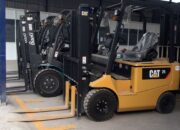Trends in New Technology Applications in the Forklift Industry
As logistics and warehouse management continue to evolve, the forklift industry is experiencing a breakthrough thanks to technological advancements. From Automated Guided Vehicles (AGVs) to Artificial Intelligence (AI) and lithium-ion battery-powered electric forklifts, these trends not only improve operational efficiency but also shape the future of the industry. Let’s explore how advanced technologies are transforming warehouse operations and supply chains.
Automated Guided Vehicles (AGVs): The Next Step in Automation
AGVs are becoming one of the most disruptive technologies in the logistics industry. These are forklifts that operate autonomously using navigation technologies such as lasers, cameras, or RFID (radio-frequency identification) to transport goods around warehouses without the need for a human driver.
Benefits of AGVs
Increased productivity: AGVs can operate 24/7, minimizing downtime and human error. This is particularly useful in large warehouses where speed and precision are essential.
Enhanced safety: Equipped with advanced sensors, AGVs can detect obstacles and stop immediately, reducing the risk of accidents in crowded work environments.
Flexibility and easy integration: AGVs can be easily programmed to perform various tasks and integrated with warehouse management systems (WMS) to optimize workflows.
Real-world Applications
AGVs are widely used across various industries. For example, in e-commerce, companies like JD.com have deployed AGVs to handle millions of orders per day, cutting delivery times and increasing accuracy. In manufacturing, automotive factories use AGVs to transport parts to assembly lines, ensuring uninterrupted operations.
Challenges of AGV Adoption
Despite the benefits, implementing AGVs comes with challenges. Initial investment costs for AGVs and the necessary infrastructure (such as navigation systems and management software) can be high, especially for small and medium-sized businesses. Additionally, maintenance and system upgrades require highly skilled technicians.
Artificial Intelligence (AI): The Future of Smart Warehouse Management
AI is revolutionizing how businesses manage warehouses. From demand forecasting to process optimization, AI helps warehouses operate more efficiently, reduce costs, and enhance customer experience.
The Role of AI in Warehouse Management
Demand forecasting: AI uses machine learning algorithms to analyze historical data, forecast product demand, and optimize inventory levels.
Process optimization: AI can plan optimal routes for AGVs, reducing travel time and improving efficiency. It also aids in scientifically organizing goods in the warehouse, saving space.
Increased accuracy: With machine vision technology, AI can quickly identify and classify goods, reducing errors in order processing.
Real-world Example
Amazon is a pioneer in applying AI to warehouse management. Its AI system has reduced inventory costs and increased order fulfillment rates by up to 30%. AI algorithms analyze data from millions of daily transactions to make optimal decisions on storage locations and delivery routes.
The Future of AI in Warehousing
The integration of AI and the Internet of Things (IoT) is expected to lead to fully automated warehouses. IoT sensors will collect real-time data, while AI will process that data to make immediate decisions. This will not only enhance efficiency but also allow businesses to quickly adapt to changing market demands.
Electric Forklifts with Lithium-ion Batteries: A Sustainable and Efficient Solution
Electric forklifts have long been considered an environmentally friendly alternative to diesel forklifts. However, the development of lithium-ion battery technology has taken electric forklifts to a new level, offering superior performance and sustainable operation.
Advantages of Electric Forklifts
Environmentally friendly: Electric forklifts produce zero CO2 emissions, making them ideal for indoor warehouses and compliant with increasingly strict environmental regulations.
Cost-saving: Compared to diesel forklifts, electric models have lower fuel and maintenance costs, offering long-term savings.
Quiet operation: Electric forklifts generate less noise, creating a more comfortable work environment for employees.
Lithium-ion Battery Technology
Lithium-ion batteries are gradually replacing traditional lead-acid batteries due to their outstanding benefits:
High performance: Lithium-ion batteries provide consistent power output, ensuring efficient forklift operation even during long shifts.
Fast charging: These batteries can be fully charged in just 1–2 hours, compared to 6–8 hours for lead-acid batteries. This allows for continuous operation with minimal downtime.
Long lifespan: Lithium-ion batteries can last 2,000–3,000 charge cycles—2–3 times longer than lead-acid batteries—reducing replacement costs.
Safety: Built-in Battery Management Systems (BMS) help prevent issues such as overcharging, overheating, or short circuits.
Comparing Lithium-ion Batteries and Lead-acid Batteries
(Let me know if you’d like to include a comparison table or chart here.)
The Rise of Electric Forklifts
The demand for electric forklifts is rapidly increasing, especially in green industries like food, pharmaceuticals, and e-commerce. Advances in lithium-ion batteries have enabled electric forklifts to compete in performance while supporting companies in achieving their sustainability goals.
The Impact of Technological Trends on the Forklift Industry
The convergence of AGVs, AI, and lithium-ion-powered electric forklifts is driving a significant transformation in the forklift industry:
Increased productivity and efficiency: Automation and AI reduce order processing times, optimize warehouse space, and improve order accuracy.
Reduced operating costs: AGVs and electric forklifts cut labor, fuel, and maintenance costs, boosting profitability.
Environmental protection: Electric forklifts and lithium-ion batteries help companies meet safety and environmental standards while building a green brand image.
Competitive edge in logistics: Businesses that quickly adopt these technologies will have a distinct advantage in the e-commerce and global supply chain markets.
These technological trends are not just a leap forward—they’re a major opportunity for logistics companies to redefine their operational strategies and meet the growing demands of the modern market.







